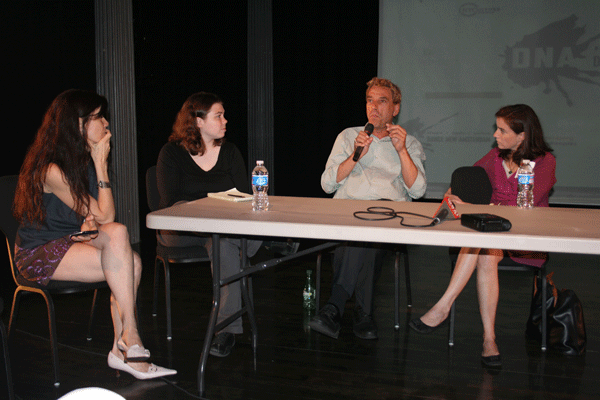[media-credit name=”Photo by Erika Latta, courtesy of Dance New Amsterdam” align=”alignleft” width=”600″] [/media-credit]BY HELAINA HOVITZ | Though it recently avoided eviction, Dance New Amsterdam, the first nonprofit organization that opened in Downtown since 9/11, is still millions of dollars in debt. Consequently, the dance studio has undertaken a five-year recovery plan whose mission is to increase individual, community and philanthropic support with the goal of avoiding raising class prices.
[/media-credit]BY HELAINA HOVITZ | Though it recently avoided eviction, Dance New Amsterdam, the first nonprofit organization that opened in Downtown since 9/11, is still millions of dollars in debt. Consequently, the dance studio has undertaken a five-year recovery plan whose mission is to increase individual, community and philanthropic support with the goal of avoiding raising class prices.
Hit hard by the recession, the organization — housed in a 25,000 square-foot facility at 280 Broadway — has to meet an immediate need of $150,000 just to stay afloat. The studio, which opens early and closes late seven days a week, employs 650 people and costs more than $2 million to operate annually.
The recovery plan entails increasing revenue by growing class and theater attendance and expanding the size and duration of its classes, among other tactics, according to Catherine Peila, the organization’s executive director. “We’re doing everything we can to stay true to our mission to provide affordable public dance space,” she said.
The economic downturn has caused D.N.A. and many other nonprofits to lose their endowments. Peila believes that creating a new business plan modeled after a for-profit business is one way to make them commercially viable. Any surplus revenue, in other words, would go right back into D.N.A. programming.
Were D.N.A. to close, the community as a whole would lose some 35,000 customers, according to the organization’s estimates, which reference neighborhood restaurants that faculty and students frequent along with such stores as Modell’s and Century 21.
“This isn’t just about one organization,” affirmed Peila. “If we go, so do a lot of businesses.”
The initiative is an outgrowth of the roundtable discussion Peila hosted in June attended by state Senator Daniel Squadron, members of Community Board 1, cultural advocate Paul Nagle and Michael Kaiser of the Kennedy Center’s DeVos Institute. Participants worked together to come up with ideas for a plan to help the center, which Squadron deems “integral to Lower Manhattan’s recovery.”
“I’m proud to stand with D.N.A.,” he said in a statement addressing the group’s five-year recovery plan. “It’s critical to our neighborhood’s emergence as one of New York’s burgeoning cultural centers.”
D.N.A. differs from other dance studios, because it doesn’t have an in-house dance company, nor does it operate within a single niche. The organization provides education and rental spaces to artists, hosts performances and teaches every type of dance in the book without requiring membership.
In adhering to its nonprofit status, D.N.A. charges minimal fees and conducts a modest amount of commercial business, according to Peila.
D.N.A. recently scored a sizeable victory in renegotiating a new, ten-year lease. Consequently, its rent was lowered by $30,000 a month, and the studio was absolved of all overdue back rent.
The studio’s recovery plan is indicative of the need for other Downtown arts organizations to examine and reform their finances and programming. It is currently partnered with the Lower Manhattan Arts League, the Tribeca Performing Arts Center and the New Museum, and aims to collaborate with additional groups in order to increase earned revenue and contributions.
“The World Trade Center Performing Arts Center will be built down here, and it would be a brilliant thing to be able to work with them,” Peila said.
Founded in 1984, D.N.A. moved to Lower Manhattan in 2006. Hailing from the non profit community herself, Peila, who first joined the organization as a consultant in 2007, became its general manager on the heels of the recession in 2008. Upon taking the helm as executive director last year, she made drastic salary cuts to the highest-paid staff and otherwise restructured the organization.
As part of its five-year plan, D.N.A. is on the active hunt for donations and sponsorship from individuals, businesses and philanthropists. Currently, the dance studio manages to provide low-cost rehearsal space, free performances and Friday classes and grants for artists to enable them to develop their work.
“The dancers aren’t asking for free classes.They just want to be able to pay for them reasonably,” said Peila. “We don’t want to have to compromise our mission to support the life, career and longevity of dance artists.”
































